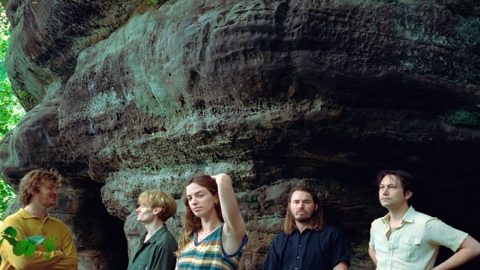
In any game, having players return to the same old place – again and again – risks invoking the dreaded B word: boredom. Letting players seek out fresh perspectives at the same locations, without getting bored of the same sights, is a very fine line to walk, but Arkane has been capering across that tightrope long before Deathloop.
- READ MORE: Dan Le Sac on turning to video game soundtracks: “it’s really similar to being in a band”
Deathloop – the studio’s latest hit – takes Arkane even further, and sets players loose in a handful of locations across the hedonistic party island of Blackreef. Anyone who’s played Deathloop knows that there’s endless nuance to be found within these locations, as different elements – including which characters have already been killed, the time of day and more – makes revisiting these locales a dramatically different experience with every jaunt. For Arkane fans, it’s probably no surprise that the studio pulled this off – after all, this is the studio that created The Clockwork Mansion – but it doesn’t diminish the question: how exactly does Arkane manage it?
For Deathloop campaign designer Dana Nightingale, it’s not just about filling each map with a rats-nest of routes for players to explore and calling it a day – it’s about making each one worthwhile to play, and more importantly, play again. In Deathloop, offering players different storylines and leads to pursue is at the heart of its campaign and gives players compelling reasons to return to each area.
“One of the things I never gave up on – and I felt like I succeeded on – was each one you play should feel different,” says Nightingale. There’s tens of leads to pursue in Deathloop, and Nightingale says it was important to ensure these leads – and all the decision-making they entail – weren’t just wrapped neatly into dialogue choices.

“It’s not just going through the motions of the same pattern of events and tricks for each one. Of course, there will be similarities because the verbs stay the same. We can do only so many novel interactions where you interact with a thing and a dialogue choice comes up. We try to do that as rarely as possible, but I wanted to approach each lead as there wasn’t a standard length. There isn’t a standard complexity. There aren’t any boxes to tick, except ideally you do meet the visionary – that it’s about. You can complete some of them without ever meeting the visionary. Some of them are even optional – you can complete the game without ever having completing them. We kind of hide that fact, but it’s definitely true. You can absolutely skip some. I didn’t want it to feel routine.”
Trying to physically incorporate a player’s freedom of choice into a game’s core level design sounds daunting, but Nightingale says Arkane doesn’t actually want players to try and break everything at once – despite the potential for chaos each level seemingly invites. Sharing insight into Arkane’s design process, Nightingale reveals that Arkane designs maps with “horizontal progression in mind”, meaning – as Nightingale puts it – players won’t be able to “have everything on the tree” in one playthrough. Instead, the idea of replayability – deliberately bringing players back to the same location to try something new – ties back in and feeds into Arkane’s philosophy on level design.
“Switching to how we did it in Deathloop, it wasn’t so much we had to change our approach to level design, we changed the approach to game design to how we’ve always done level design. You can go into these maps – you enter the space, and you see you’ve got five different ways you can go and you’ve got to pick one. Well, now you can pick all five – because you’re coming back over and over again.”

These routes are further muddled by the sheer scope of events that players can affect in Deathloop. If you spend all morning causing havoc in Karl’s Bay, for example, and return there in the evening, you’re bound to notice some differences – and vice versa, when the map physically changes, so do your options for traversing it. Nightingale says that from a design perspective, these routes are less about being “interesting” for players, and more about being both satisfying and rewarding to players.
“You see a crawl space under the building, and that’s not going to be an interesting route – we’re not going to try and make it interesting,” says Nightingale, before arguing that it should instead offer something that is tangibly rewarding for players to pursue. Switching to a player’s perspective, Nightingale explains:
“I notice that path, and when you come out the other side, I’m in a good position now to approach the rest of the map. Before I came in this way, I had to deal with this challenge. I bypassed that one, but now I have a slightly different one because I’m on the ground level, so I don’t have a good vantage point – but I’ve skipped that locked door, or whatever. So we’re less worried about making each path interesting, and more…what is the pro and con of each path? What is the moment of satisfaction, of ‘I’ve discovered this and got something different’?”

Arkane is no stranger to weaving captivating pathways across its many maps. The studio’s signature abilities – from Dishonored‘s iconic blink to Deathloop‘s shift slab – could all prove nightmarish for the sensibilities of some level designers, but in the world of Arkane, boundary-pushing is a welcome challenge. Speaking of challenge, Nightingale says that the real trick for Arkane’s level designers is ensuring the game remains difficult when players already own the keys to the kingdom.
“The player has great mobility so we have to construct paths that make that still fun, so you’re not just skipping all the challenges in the map. At the end, the player still wants to be challenged – if you give them a way so they’re not challenged they’ll always take that way. The challenge for us is how to keep the player from optimising the fun out of the game and if the player finds a way to do that, they’ll do that every time.”
In one case, Nightingale reveals that Arkane actually added in a completely new way to approach ‘The Ballad Of Ramblin’ Frank’ (Frank’s lead in Deathloop) late in production, because developers noticed that many playtesters were gravitating toward an approach that wasn’t in the game.

“We’ll see that players are approaching that lead in a totally different way, and they understand it. They’re not lost or confused, but their instinct is to approach it like this and the game wasn’t letting them. So, we were able to scramble and using the resources we had very late, say, ok, how can we adapt this to allow the way players are approaching it to be valid?”
With having so many routes in Deathloop – plenty of which affect how each level is seen by the player – Nightingale explains that Arkane spent a lot of time “threading the needle between the technical challenge of just managing the data” that players accumulated by piling decision upon decision.
Beyond the gameplay, Nightingale highlights the importance of just making these levels visually appealing for players to explore. At first, Arkane gives the floor over to its level designers, who – after crafting the “rhythm” of the world – pass it on, and are left “really trusting the art team” – which is why Arkane’s games share quite a similar aesthetic.

On that note, Nightingale is quick to point out that bringing places like Blackreef to life falls to more than just the level designers. She pauses to “praise the talents of [Arkane’s] narrative team” and says that matching Deathloop‘s shifting tone to the world of Blackreef is “all on them”. Likewise, the art team is responsible for bringing these intricate maps to life.
“A level designer will focus completely on the flow of spaces, the organisation of paths, the rhythm of challenge vs the moment of realising the challenge –approaching the challenge – [and] overcoming it. We’re always building with rhythms like that in the [earliest stage of development] and just trusting our art team will be able to take what we’ve done and create this amazing reimagined version in our art style, in our architectural style. What we can imagine, they can reimagine in that form.”
“We have this great big talented team. They’re just full of ideas. They’re stuffing the maps filled with all these clever things. There isn’t a team leader with a checklist to say, ok, you all have to do this, that, and the other. It’s just a case of the level designers talking amongst themselves and saying, ‘wouldn’t it be cool if’, and doing it.”
Additional reporting by Jake Tucker.
Deathloop is available on PS5 and PC. NME recently named Deathloop as one of the best games of 2021 – you can check out the full list to see where it ranked.
The post How Arkane designed a map worth revisiting in ‘Deathloop’ appeared first on NME.





